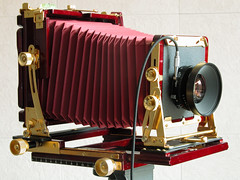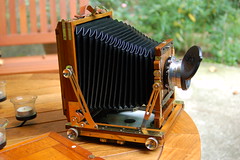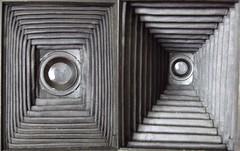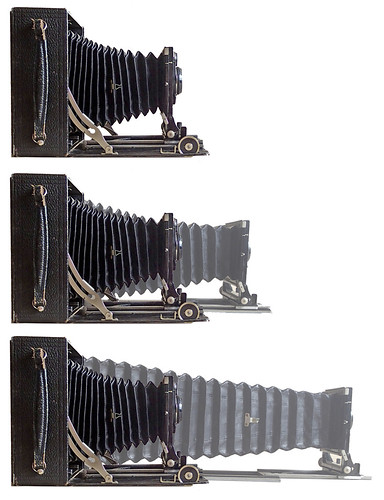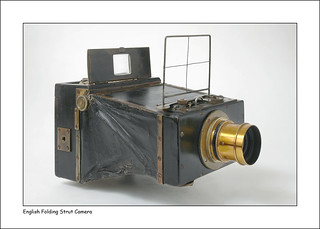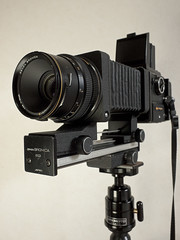Bellows
A bellows[1] is a lightproof tube, rectangular in section, made from an opaque, flexible material (leather, leatherette, vinyl, etc.), with lateral folds that allow it to retract or extend in length.
Bellows are used in cameras in several ways:
- They are a permanent part of the body of some cameras.
- A bellows is also an accessory for close-up photography, essentially an extension tube of variable length.
- A bellows lens hood (or compendium hood) is a hood of adjustable depth, used with view cameras or sometimes with SLRs.
Bellows as a permanent part of the camera
Compactness
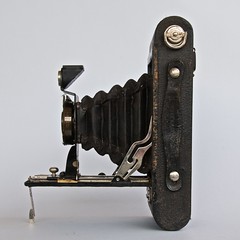
|
| Kodak No. 2A Folding Autographic Brownie. Bellows allow folding cameras to collapse into a small body. image by Dirk HR Spennemann (Image rights) |
The simplest use of bellows is to achieve compactness in a folding camera. The bellows extend to form part of the lightproof body of the camera while in use, and retract into a very compact size inside the rigid part of the body when the camera is folded.
If the bellows is not involved in focusing (see below), then unfolding the camera requires only that the bellows be extended to the same fixed position each time. Most folding cameras of this sort have a folding strut mechanism associated with the front door, which serves to hold the lens standard more or less rigidly in the correct position when the camera is unfolded. Many folding cameras, especially later ones, are 'self-erecting'; that is the lens standard and bellows are automatically put in position when the door is released.
Other arrangements also occur. In 'strut-folding' cameras such as the Foth Derby the lens board is simply pulled out from the body to a more or less definite fixed position for use.
Focusing

|
| Zeiss Ikon Bobette II. The radial focus control lengthens the focus scale, allowing more accurate use. image by Dustin McAmera (Image rights) |

|
Focus scale on the bed of an ICA Halloh 570 image by Süleyman Demir (Image rights) |
The variable extension of the bellows is used to provide the focusing in some cameras. This is most familiar as a feature of view cameras, with a ground glass screen, but bellows focusing is also used with rangefinder cameras (for example the Speed Graphic) and SLRs such as the Mamiya RB67. Some folding cameras use bellows focusing with no other aid than a scale fixed alongside the lens standard (some of these are cameras designed before triplet lenses, which allow easy focusing by moving the front element).
In folding bellows-focusing cameras the front door usually opens to form a focusing bed, with rails upon which the lens standard moves.
Some SLR bellows cameras such as the Soho Reflex, the RB67 and the Rolleiflex SL66 use a rack-and-pinion system for focusing instead of a baseboard and rails, with a pair of toothed racks attached to the front board of the camera. Their purpose is the same however; because of the flexibility of the bellows, some rigid mechanical system is needed to hold it at the right extension.
A special case are monorail cameras, a type of view camera in which the 'body' comprises little more than the bellows.
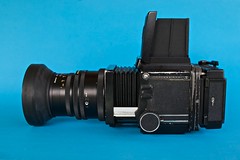
|
| RB67, showing the bellows and left-hand focusing rack image by Dirk HR Spennemann (Image rights) |

|
| Omega View 45D monorail camera image by Elmo Alves (Image rights) |
Camera movements
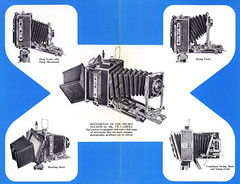
|
| Leaflet for the MPP Micro-Technical Mk VII image by Ian Grant (Image rights) |
The most advanced use of bellows is to allow camera movements: rise and fall, left and right shift, tilt and swing. These movements allow advanced control of the plane of focus, and of perspective. Again, camera movements are most frequently a feature of view cameras, but front rise in particular is often available on other bellows cameras, even in some where there is no way to judge the effect.
The bellows itself only maintains the lightproof enclosure by its flexibility. It is mechanical systems associated with the lens standard and/or the back-plate that achieve the camera movements.
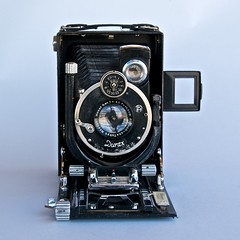
|
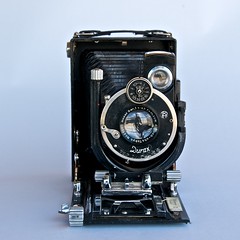
|
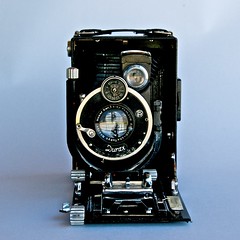
|
|

|
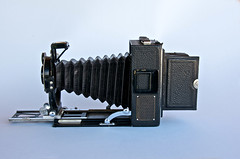
|
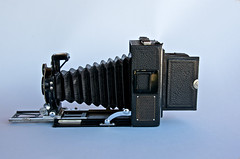
|
|
| Lens board movements. Top: front shift, left and right. Bottom: Front rise and fall. Konishiroku Lily, 6.5×9cm with Hexar Ser.1 10.5cm f/4.5 lens in Durax shutter, Images by Dirk HR Spennemann (Image rights) | |||
Taper
Bellows on simple cameras such as medium-format folders are often tapered (that is, the width decreases) toward the front. This simply avoids making the lens plate bigger than necessary, and reduces the material required to make the bellows. Since the layers of the tapered bellows do not sit exactly over one another when folded (see below right), it may also fold more compactly. Bellows on 35 mm folders are usually not tapered (simply because the lens plate is no smaller than the film format).
View cameras often have little or no taper in the bellows, because this gives greater flexibility for tilt and swing. Again, this is by no means an absolute rule.
|
|
|
Length
|
The length of the bellows clearly affects what lenses can be used with it. For a normal lens construction, the back-focus (at infinity focus) is about the same as the focal length, so a bellows of that length will just allow it to focus at infinity. To focus any closer requires a longer bellows. In view cameras, a bellows may be described as double- (or triple-) extension, meaning twice (or three times) the focal length of the normal lens for the camera.
On the other hand, the many folds of a standard bellows may be a nuisance when working at very short bellows extension with a wide-angle lens, especially if movements are wanted. Short bellows are sometimes used in this situation. There are also 'bag' bellows, with a single loose outward fold, for use at short extension.
|
Bellows for Macro photography
|
On a rigid camera with interchangeable lenses, such as an SLR, a bellows fitted between the camera body and the lens can extend the lens' close focus capability (the further the lens is from the film, the closer it is focused). The length of the bellows is controlled by one or more rails. It serves exactly the same function as an extension tube, but can be adjusted to any length (up to that of its rails).
Most makers of system cameras have provided bellows that support automatic aperture stopdown, such as Nikon, Minolta, Bronica, Canon, Exacta, Hasselblad, Miranda, Olympus, Pentax, Zeiss-Ikon as well as a few third party companies such as Soligor, Vivitar, Novoflex, etc.
This type of bellows are generally not tapered, simply because they connect lens mounts of the same size.
Since the bellows is a hollow pleated tube, each side of the bellows has a plate with the camera system mount to attach the body or the lens, third party bellows can be fitted with universal mounts (T-mount or similar) or have interchangeable mount adapters.
A good bellows allows at least 3 movements and the ability to lock the position of all these movements is very important:
- Front movement of the lens closer or farther to the camera
- Back movement of the camera closer or farther to the lens
- Whole mechanism can move closer or farther to the subject
- Optionally Tilt and shift movements are found
|
Length of the bellows (L), focal length (F) and f/stop of the lens determine the magnification (M) and distance from subject (D), and amount of loss of light when taking macro photos.[2][3]
Magnification by bellow length: M = (L-F)/F
Distance to subject: 1/F = 1/L + 1/D
Exposure compensation = 2*log2(L/F) stops
Accessories to bellows included flash, double shutter release, slide copier, etc.
Notes
- ↑ Bellows is both the singular and the plural.
- ↑ Bellows and calculations at Extreme Macro Photo
- ↑ Bellows Formulas by Kenneth Lee
